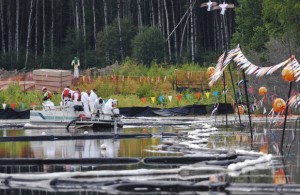By Chris Varcoe, Calgary Herald October 9, 2013
Municipal Affairs Minister Doug Griffiths will journey to China this week to share information on Alberta’s “successes in responding to the June floods,” prompting oppositions MLAs to blast the trip as an arrogant waste of taxpayer money.
The province announced Tuesday that Griffiths — who has headed up the government’s emergency response to flooding in southern Alberta — will travel to China for a 10-day mission beginning this weekend, at a cost of $33,000.
The trip will focus on “outlining how Alberta responded to the worst flooding disaster in the province’s history and learning about China’s expertise in disaster response,” according to a government release.
Griffiths wasn’t available for an interview, but said in the statement that “Alberta’s emergency management model is internationally renowned, and we are keen to share information on our successes in responding to the June floods.”
Opposition politicians condemned the international excursion, calling it a sightseeing trip with little value.
“Are you serious?” NDP MLA Rachel Notley said Tuesday.
“As much as the people of China may or may not gain from our so-called expertise, really, he should be focusing his time on actually bringing about a successful resolution to the disaster that we face.”
Liberal critic Laurie Blakeman lambasted the minister for saying he would discuss how well the province handled the disaster, which forced more than 100,000 people from their homes and caused an estimated $6 billion in damages.
Blakeman noted that after major floods in 2005, the Tories ignored key recommendations from their own internal report that might have mitigated some of the damage caused this spring.
“To be striding about in another country claiming that we have great anti-flood methods is a bit rich,” she said.
Wildrose MLA Rob Anderson said he was particularly “baffled” by the decision to go to China to discuss disaster response, given the Asian country’s record on dealing with human rights, individual freedoms and property rights.
“We generally don’t look to Communist, totalitarian governments to explain to us how to properly conduct ourselves in the case of a disaster,” Anderson said.
“It’s like going to Iran to learn about promotion of religious freedom. It makes no sense.”
But Griffiths’ press secretary said the minister was spending time in Shanghai because that’s where the conference is being hosted.
“It’s not just Chinese delegations, but countries from all over the world are attending this,” said Kathleen Range. “The Expo is also an opportunity to promote Alberta businesses that specialize in disaster response.”
According to the province, Griffiths will meet with regional disaster management experts and attend the Shanghai International Disaster Reduction and Security Show from Oct. 17 to 19. In Harbin, the MLA for Battle River-Wainwright will meet local officials and discuss possible joint projects on disaster preparation.
Derek Fildebrandt of the Canadian Taxpayers Federation, a frequent critic of government travel, didn’t fault Griffiths for heading to China, but said the price tag seems a bit high.
“He is the guy responsible largely for the flood file and flood relief file, so his reason for going doesn’t seem far out,” said Fildebrandt. “But $33,000 does seem like a fair bit of money for two people to be travelling for what, 10 days?”
— With files from James Wood, Calgary Herald
 Canadian Natural Resources Limited (CNRL) workers cleaning up the bitumen emulsion on this marsh after it seeped up through a fissure under the water at their Primrose oilsand projects north of Cold Lake, August 8, 2013. A total of four sites have this seepage.
Canadian Natural Resources Limited (CNRL) workers cleaning up the bitumen emulsion on this marsh after it seeped up through a fissure under the water at their Primrose oilsand projects north of Cold Lake, August 8, 2013. A total of four sites have this seepage.